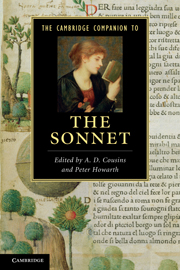Book contents
- Frontmatter
- Introduction
- 1 Contemporary poets and the sonnet
- 2 The sonnet and the lyric mode
- 3 The sonnet, subjectivity and gender
- 4 The English sonnet in manuscript, print and mass media
- 5 European beginnings and transmissions
- 6 Desire, discontent, parody
- 7 Shakespeare’s Sonnets
- 8 Sacred desire, forms of belief
- 9 Survival and change: the sonnet from Milton to the Romantics
- 10 The Romantic sonnet
- 11 The Victorian sonnet
- 12 The modern sonnet
- 13 The contemporary sonnet
- Further reading
- Index
11 - The Victorian sonnet
Published online by Cambridge University Press: 28 May 2011
- Frontmatter
- Introduction
- 1 Contemporary poets and the sonnet
- 2 The sonnet and the lyric mode
- 3 The sonnet, subjectivity and gender
- 4 The English sonnet in manuscript, print and mass media
- 5 European beginnings and transmissions
- 6 Desire, discontent, parody
- 7 Shakespeare’s Sonnets
- 8 Sacred desire, forms of belief
- 9 Survival and change: the sonnet from Milton to the Romantics
- 10 The Romantic sonnet
- 11 The Victorian sonnet
- 12 The modern sonnet
- 13 The contemporary sonnet
- Further reading
- Index
Summary
Toward the end of the reign of Queen Victoria, Oscar Wilde’s literary detective story ‘The Portrait of Mr W. H.’ sketched the ‘onlie begetter’ of Shakespeare’s Sonnets, a young actor speculatively called ‘Willie Hughes’. Wilde’s narrator said that Hughes was ‘not merely a most delicate instrument for the presentation of [Shakespeare’s] art, but the visible incarnation of his idea of beauty’. First published in 1889 and extensively revised before his death in 1900, the story is a late Victorian reply to the censure of the Sonnets at the beginning of Victoria’s reign, in particular to Henry Hallam’s notorious comment, ‘it is impossible not to wish that Shakespeare had never written them’. Hallam’s objection to the ‘weakness and folly in all excessive and misplaced emotion’ was an allusion to the unsayable, the love that dare not speak its name. Yet Hallam’s son Arthur Henry Hallam might also have been one of those ‘young men of poetical tempers’ whom the older Hallam said shared a tendency ‘to exaggerate the beauties of these remarkable productions’. Certainly Hallam’s friend Alfred Tennyson ’s view ‘in his weaker moments’ (according to Benjamin Jowett), that Shakespeare was ‘greater in his sonnets than in his plays’, caused a slight loss of nerve in Tennyson’s biographer, his son Hallam Tennyson. Reprinting Jowett’s memoir, the younger Tennyson excised the gloss suggesting his father had ever ‘expressed … a sort of sympathy with Hellenism’.
- Type
- Chapter
- Information
- The Cambridge Companion to the Sonnet , pp. 204 - 224Publisher: Cambridge University PressPrint publication year: 2011



